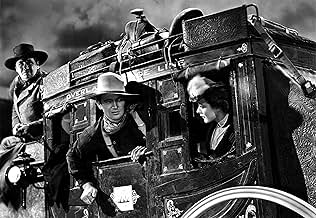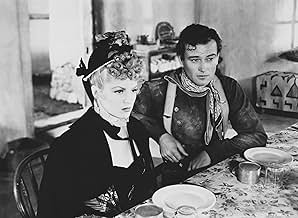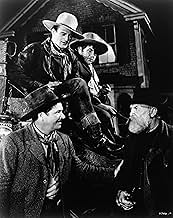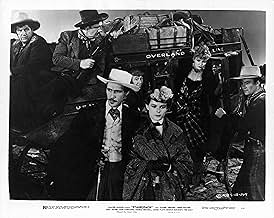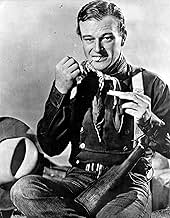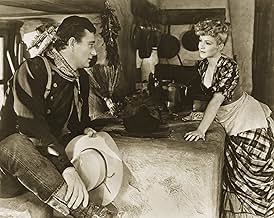Eine Gruppe, die mit einer Postkutsche unterwegs ist, rückt wegen der Bedrohung durch Geronimo zusammen und erfährt dabei mehr übereinander.Eine Gruppe, die mit einer Postkutsche unterwegs ist, rückt wegen der Bedrohung durch Geronimo zusammen und erfährt dabei mehr übereinander.Eine Gruppe, die mit einer Postkutsche unterwegs ist, rückt wegen der Bedrohung durch Geronimo zusammen und erfährt dabei mehr übereinander.
- Regie
- Drehbuch
- Hauptbesetzung
- 2 Oscars gewonnen
- 10 Gewinne & 5 Nominierungen insgesamt
- Girl in Saloon
- (Nicht genannt)
- Indian Scout
- (Nicht genannt)
- Bit Part
- (Nicht genannt)
- Bit Part
- (Nicht genannt)
- Lordsburg Saloon Owner
- (Nicht genannt)
Empfohlene Bewertungen
Although I miss seeing the desert landscape in full yellows and blues, this film is one of my favourite westerns and only suffers a little by being in black & while and not really enjoying the visual sweep that later Ford westerns had. The plot is quite simple on one hand - a group battle Indians on their way to a town while some of the characters confront their own battles. However this succeeds because it is more than just a B-movie shoot'em up, it has characters and sub plot.
The characters may be quite broad and the film may well use them like a disaster movie (set them up just enough to care about and then see who gets knocked down) but it does have touches that improve it. Characters are shunned due to their social status, `good' people are revealed to be not so good as they think themselves while `bad' people reveal themselves to have good hearts and the potential for redemption in their lives. While it isn't earth shattering it is well crafted and well written in the context of the traditional western.
Wayne is good and this film allowed him to step up from B-movie westerns to the type of films that made his career. The rest of the cast are also good in their various roles, while the characters are broad they all play it well, especially Trevor, Devine, Mitchell and Carradine.
Overall this is a solid western that has good action (include a great stunt that was lifted directly into Raiders of the Lost Ark) but also has characters and interactions which make for a polished and enjoyable movie.
The first pairing of Ford and Wayne changed the course of the modern Western turning into adult Western , portraying in depth characters and brooding events with allegorical issues running beneath surface script . But the movie's little budget looked cash well spent when this classic picture earned more than two million dollars on first exhibitions . Based on the story 'Stage to Lordsburg' by Ernest Haycox and this one based on Guy de Mauspassant's novel . Outstanding cinematography capturing the nebulous skies by Bert Glennon and Ray Binger . Thrilling as well as sensitive soundtrack by Richard Hageman based on traditional music . Slick edition by Dorothy Spencer , a woman with a long career during fifty years . Stunning shooting by John Ford in the mythical Monumental Valley , a place that Ford was often to revisit and he befriended Indians tribes . The film won Academy Award for secondary actor , Thomas Mitchell , original musical score and was nominated to best movie for Walter Wanger and major studio , United Artists ; furthermore, for edition and Production Design . Very inferior remake in 1966 by Gordon Douglas with Alex Cord , Anne Margret , Red Buttons , Van Johnson , Mike Connors ; and a forgettable adaptation for TV in 1986 by Ted Post with Willie Nelson , Johnny Cash , Elizabeth Ashley , Mary Crosby , Tony Franciosa , John Schneider and Kris Kristopherson.
Wusstest du schon
- WissenswertesYakima Canutt explained how the stunt was accomplished where, as an Apache warrior attacking the stagecoach, he is "shot", falls off his horse, and then gets dragged underneath the stagecoach: "You have to run the horses fast, so they'll run straight. If they run slow, they move around a lot. When you turn loose to go under the coach, you've got to bring your arms over your chest and stomach. You've got to hold your elbows close to your body, or that front axle will knock them off." After the stunt was completed, Canutt ran to director John Ford to make sure they got the stunt on film. Ford replied that even if they hadn't, "I'll never shoot that again."
- PatzerBefore Ringo hands his Winchester rifle to Curley after finding him stranded outdoors on the stagecoach trail, he ejects a chambered round, which after flying behind his head, can be heard as a knock as if hitting the soundstage floor. Also, it would have been unrealistic to waste a live round of ammunition with hostile Indians in the area, especially after telling Curley that he (Curley) may need his Winchester.
- Zitate
Marshal Curly Wilcox: Come busting in here - you'd think we were being attacked! You can find another wife.
Chris: Sure I can find another wife. But she take my rifle and my horse. Oh, I'll never sell her. I love her so much. I beat her with a whip and she never get tired.
Dr. Josiah Boone: Your wife?
Chris: No, my horse. I can find another wife easy, yes, but not a horse like that!
- Alternative VersionenAlso available in a computer-colorized version.
- VerbindungenEdited into Laramie (1949)
- SoundtracksTrail to Mexico (Bury Me Not on the Lone Prairie)
(uncredited)
Traditional ballad
Variations played throughout as part of the score
Top-Auswahl
- How long is Stagecoach?Powered by Alexa
Details
- Erscheinungsdatum
- Herkunftsland
- Sprachen
- Auch bekannt als
- Stagecoach
- Drehorte
- Agathla Peak, Arizona, USA(Peak in background at start of stagecoach trip)
- Produktionsfirma
- Weitere beteiligte Unternehmen bei IMDbPro anzeigen
Box Office
- Budget
- 392.000 $ (geschätzt)
- Laufzeit
- 1 Std. 36 Min.(96 min)
- Farbe
- Seitenverhältnis
- 1.37 : 1




